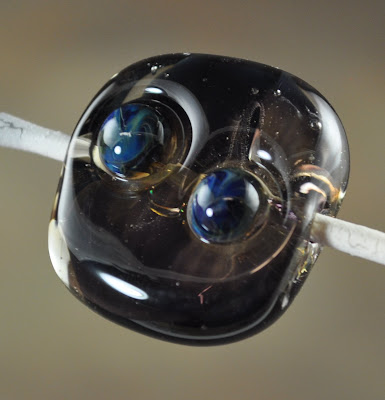
EDP - Evil Devitrifying Purple (EDP for short). Evil Purple. Effetre 254. Oh yeah - there is no one on the fence about this colour!
With a reputation for being hard to work, a tendency to shockiness, a thoroughly intimidating price tag and seemingly unpredictable results - many folks love to hate this glass.
(It's made with gold - btw - hence the price.)
But me - I love it!
Here's the first dirty little secret about EDP - not all batches are created equal. So when you find a batch that is well behaved and works nicely - stock up!
For instance - I recently came across a couple of pounds of a very-well behaved batch - so I bought it all. It had been lying around for a couple of years - so it is an older batch. Admittedly - I do go through a lot of it in my production work - so for some of you - 2 pounds might be a life-time supply. For me, about 6 months, maybe less.
EDP is known for 2 properties: it is very reactive and can do many interesting things other than lying around being purple, although that is not a bad thing in and off itself. I'm not talking about it's reactive properties at the moment though.
The other thing is does is "de-vitrify" - which means to loose it's glossy look. (I've had someone with rather more knowledge than me tell me that de-vitrify is not technically correct - but he didn't know what else to call it either.)
When I first started - I thought of it as "self-etching" - it would go dull and matte, instead of glossy.
I found that when I worked it normally - make a bead, and then in and out of the flame, keeping it warm while I worked on it, decorated it, it went all matte.
But if I just wound off a spacer and stuck it in the kiln - it was a lovely, deep, shiny purple. Hmmm.
So this is the key - the gentle rewarming, kissing it with a flame, after it has cooled to not-moving, makes the surface go dull. If, however, the last thing that happens to it before it goes in the flame is that it is heated to glowing, it will come out shiny.
It's that simple.
So that does mean - there are some things you just can't do - like a shiny bead with raised dots, because getting the base bead hot enough to make it shiny will melt the dots in. Well - not impossible maybe, if the dots are really big, but you get where I'm going with this. A matte bead with shiny dots in another colour - very do-able - nice contrast too.
The other thing to bear in mind is that some batches will de-vit more than others. I've had some that are so extreme - that it causes the other glass on the same bead to de-vit (which leads some weight to the it's not really de-vitrifying argument).
I've had some rods that you could just hold in the flame under a bead with no EDP in it, and cause the whole bead to go matte.
Here is the de-vit'd beads from the above-mentioned well-behaved batch. These show a very subtle, soft effect, and not so much of the "chalkiness" that some batches have. Hence part of the reason why I'm liking it.

And these are the ones that are nice and glossy. Note the dots - Eff. Turq and CiM Celadon - nice separation of colours to give a two-colour dot effect.

And here is a close up - nice and glossy. This batch seems also more streaky than most. (That powdery marking is powder - bead release from the bottom of the kiln.)

Don't be afraid of the evil purple. Heat the surface to glowing as the last step before you kiln it, and you'll have lovely, glossy purple beads.
(What about encasing? - I get asked. It goes streaky and not as vibrant if you encase it. Not a bad thing, but not the same intense purple.)

 And this is over white.
And this is over white. Nice transparent - assuming you have a use for grey.
Nice transparent - assuming you have a use for grey.










































